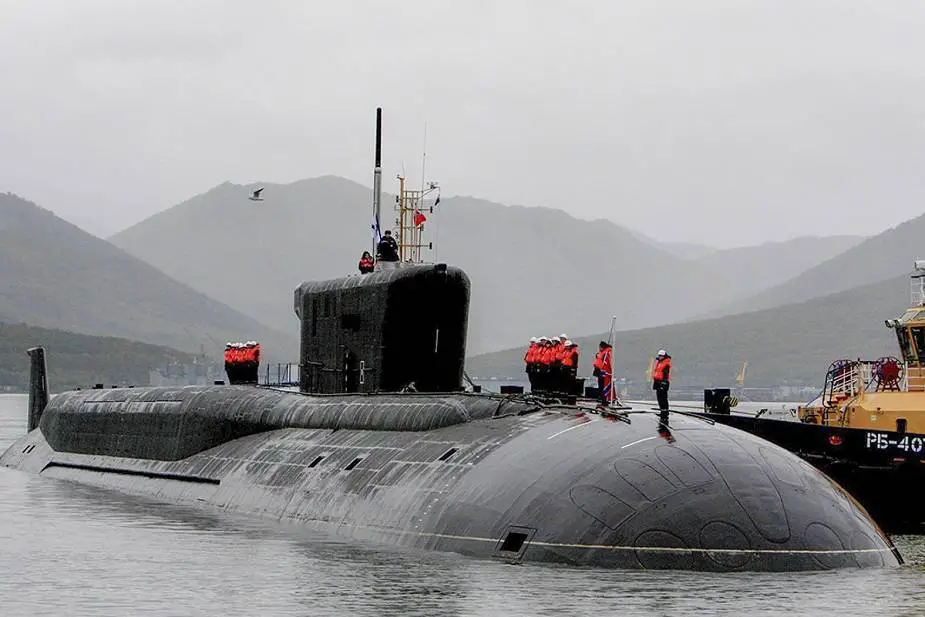The Russian Navy has one of the largest submarine fleets in the world with an estimated 58 submarines. Russia continues to modernize its submarine forces in recent years and invests huge budgets of research, design, and building new production centers.
Follow Navy Recognition on Google News at this link
 Russian navy K-550 Alexander Nevsky nuclear ballistic missile submarine of the fourth generation Borei class Project 955A. (Picture source Wikimedia)
Russian navy K-550 Alexander Nevsky nuclear ballistic missile submarine of the fourth generation Borei class Project 955A. (Picture source Wikimedia)
The production of SSN (Submersible Ship Nuclear) by upgraded project Chinese Type 093B (sometimes 095) is also planned. They will have an additional compartment with vertical launchers for cruise missiles. US SSN fire Tomahawk missiles from them, while Chinese submarines fire cruise missiles from 533mm torpedo launchers. It is so far unclear whether project 093B is successful. There were cases when Chinese industry stopped production because of unsatisfactory characteristics of the lead ship.
The Pentagon estimates the total underwater Chinese component at 60-75 submarines. Ageing subs will be replaced by new ones in a one-to-one ratio. Today only six Chinese subs of project 093 oppose 50 US nuclear submarines. All 46 Chinese diesel-electric subs, including 12 Russian-built, are modern, but have a low autonomy because of the power plant.
China continues to build all classes of submarines, but nuclear ones comprise a minority. The top Chinese leadership has likely adhered to the principle of minimal sufficiency. However, it may change the stance because of a sharp aggravation of relations with Washington. Still, there is no evidence of the radical revision of the shipbuilding program.
The Russian Navy has close to 40 multirole submarines. Half of them are nuclear-powered (including standby and overhauled subs). Russia also has a dozen of unprecedented special-task submarines (deep-water stations and their carriers, etc.) and they have to be counted for comparison with other countries.
The analysis of the Russian shipbuilding program in the first twenty years of the XXI century shows that the national leadership is working to maintain the naval strategic nuclear deterrence at a high level and earmarks major funds to operate Soviet-built SSBN and construct new ones. The Navy operates the Ryazan only second-generation SSBN (Ship, Submersible, Ballistic, Nuclear), six third-generation SSBN of project 667BRDM, three Borey-class subs of project 955, and one Borey-A-class sub of project 955A.
As SSBN need protection while going from the base to the ocean, the Navy ordered a major batch of diesel-electric submarines and focused on project 636. Eight submarines of project 636.3 have been built since 2010. The construction of another two is nearing completion and three more are to be laid.
Several submarines of Kilo-class project 877 have been overhauled and ten of them are operational. The production of Lada-class project 677 diesel-electric submarines is prepared. The St. Petersburg lead sub has been built and the Kronshtadt is undergoing trials. The Veliky Luki will be floated soon. Contracts for another three submarines have been signed.
Project 636.3 and 677 diesel submarines are modern ones and, besides SSBN protection, can engage in a broad range of brown-water missions and destroy surface and coastal targets with Kalibr missiles. The export option is Club-S. Eight out of 12 Russian-built Chinese submarines received by 2006 are armed with them. Beijing is no longer interested in the subs, as local shipbuilders are producing similar U-boats. They have already delivered 13 diesel-electric subs of project 039 and seventeen of project 039A/B and continue the construction to bring the number to 25 by 2025.



